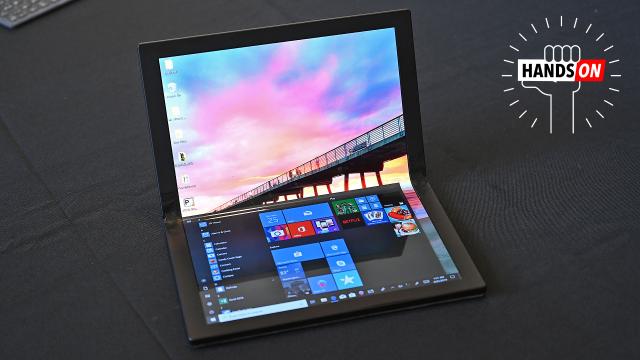We’ve already seen the arrival of flexible phones like the Samsung Galaxy Fold and Huawei Mate X, and while the excitement around these gadgets may have been dulled somewhat by concerns about durability, that isn’t stopping Lenovo from taking bendy screen tech and applying it to something bigger.
That’s where this thing comes in, and I say “thing” because Lenovo’s new flexible prototype isn’t exactly a laptop in the traditional sense. In fact, Lenovo doesn’t even call its prototype a laptop, and instead uses foldable as a sort of catch-all designation. On top of that, Lenovo hasn’t give its prototype an official name either. As evidenced by the ThinkPad logo on its lid, it will be part of the ThinkPad X1 family, but that’s about as far as Lenovo has gotten when it comes to giving it an actual title.
When it’s closed, Lenovo’s prototype looks a lot like a mix between a traditional clamshell and a detachable 2-in-1 like a Microsoft Surface. There’s a hinge in the middle that holds the two halves together, a kickstand in back, and even a little loop for stashing its Wacom-powered stylus. But then you open it up, and it’s a whole new world.
Instead of a screen up top and a keyboard down below, the inside of the prototype ThinkPad has 13 inches of screen, with a 4:3 2K resolution and vibrant OLED display tech. And unlike the Galaxy Fold, the display on Lenovo’s concept isn’t made by Samsung or whatever unnamed supplier Huawei uses, but LG, which is making its debut in the bendy screen game on Lenovo’s prototype.
In normal laptop mode, the Lenovo’s prototype features a 10 inch “half screen” that lets you use the bottom of the screen as a touch-based keyboard, secondary display, or whatever else you want. But if you want to maximise the prototype’s screen real estate, you can also pair the device with its companion Bluetooth keyboard to get a more traditional laptop experience. Lenovo’s prototype also has a built-in IR camera for use with things like Windows Hello facial recognition, along with two USB-C ports for data and charging, stereo speakers, and what Lenovo promises will be “all-day” battery life.
And that’s about it as far as this prototype’s concrete specs are concerned, because while Lenovo is teasing the device today, it won’t start shipping until sometime in 2020. Lenovo won’t even say what OS this will run, other than it will be Windows-based device of some sort. That said, even in its unfinished state, Lenovo’s folding screen ThinkPad prototype feels pretty fantastic.
Yes, it is a bit thick and heavier than a regular laptop, though part of that is probably due to some of the shrouding used to keep some of its design and components hidden. However, unlike the Galaxy Fold, there’s no crease, bumps, or rippling on Lenovo’s device. It’s just one smooth sheet of bendy display, and with it, the possibilities are endless.
You could use it to watch a video or presentation while jotting down notes or sketches with the stylus on the lower half of the screen, play a game while using the rest of the screen to check Discord or Slack, or potentially create a bunch of custom virtual bottoms as if the bottom screen was one of Apple’s TouchBars on steroids. Regardless of what you use it for, the real value is that half of the laptop’s interior surface area is no longer dominated by a static, physical keyboard.
Now obviously, Lenovo’s prototype laptop isn’t going to be a system for everyone. Lenovo imagines the product will work best for super mobile business types, road warriors, and most importantly, tech enthusiasts who may be more tolerant of first-gen awkwardness. And while you can use the ThinkPad prototype on your lap in notebook mode, 10 inches doesn’t exactly give you a lot of room to work with, though it might actually fit on the ever-shrinking tray tables found in today’s aeroplanes.
To help prevent worries about potential fragility, Lenovo says that before its prototype ever hits the market, it will have to pass the same military-grade testing as a standard ThinkPad laptop, while also surviving double the amount of hinge cycle testing.
Lenovo says its bendy-screen prototype has already been in development for three years, which is a bit less than the eight years Samsung spent working on the Galaxy Fold. But if you look even further back to devices like the Yoga Book and Yoga Book C930, it’s clear Lenovo has been building up to something like this for quite a while.
And while this prototype remains a long ways off from being real, it’s still damn exciting. After foldable devices like Galaxy Fold came to shake up smartphone design, it seems Lenovo’s prototype could do the same for the laptop space. Almost three years ago, my colleague Alex said the original Yoga Book was “the future of laptops”, and with this prototype, it feels like that future just got way more tangible. Now we’ll have to wait until 2020 to see how it turns out.
